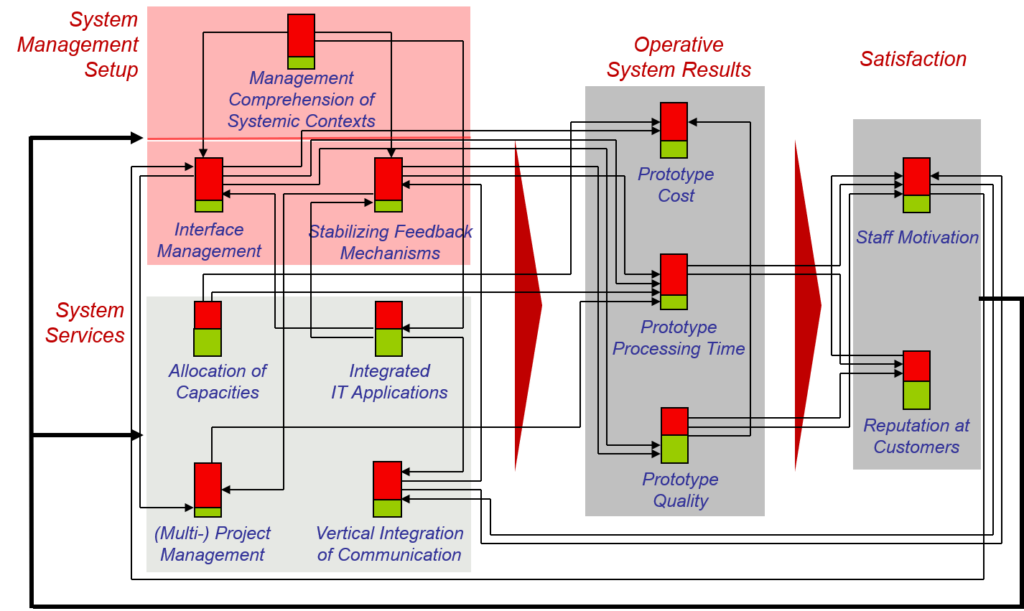Try out the proven CyberPractice® approach to make collaboration in your company significantly more effective and efficient. Components for successful cooperation are a holistic, networked approach, optimized processes, a holistic product development as well as end-to-end design of contracts and finally the mood of cooperation.
A core idea of the CyberPractice® approach according to Dr. Boysen is to dig sufficiently deep into the root cause analysis to ensure that cause-effect relationships are better understood and the effects of the interaction are specifically influenced. In practice, we often observe that complex issues are inappropriately reduced, which leads to wrong decisions. It is usually of no use just treating the symptoms that appear on the surface locally. In fact, the usually perceived “pain points” are often effects of deeper lying weaknesses in the system, which are more difficult to detect. Therefore, the causes of problems must be sought at least at the performance level, where measures and effects are fully included in the classic categories of “cost,” “time,” and “quality.” But it is not enough for activities to simply aim to streamline key performance indicators (KPIs) in these categories and to focus on implementation discipline. Rather, the pre-conditions must be created for operational results to be truly improved. These preconditions can only be influenced by optimizing the interplay of the interdependencies. The CyberPractice® process model can be used effectively for this optimization task.

The figure illustrates the main coupling effects. If you follow the thin arrows, you can see which consequential effects are triggered by effects. Finally, one also recognizes that the overall effect in turn positively feeds back to the starting conditions (bold, outer arrow). The colors illustrate a snapshot of the respective conditions, where the ratio of the green to the red parts symbolizes the quality of the conditions.
If managers’ understanding of systemic relationships is sharpened, top executives will no longer look primarily at the business units and functional areas as the drivers of successful business. Instead, they will focus on the in-between, on the connections between specialists, between business units and companies. And they will better recognize the potential of the capabilities that can result from such connections. They will also perceive the benefits of redundancies that result from meaningful networking, redundancies not as duplication of resources in the classic sense, but in such a way that different elements in the system can perform the same functions if they are versatile.
To ensure that these valuable connections function well, systemically trained managers will work to ensure that the systemic interfaces are clearly defined and that interface requirements are agreed upon, and that stabilizing feedback mechanisms are used in the process (management set-up). The process under consideration is redesigned according to cybernetic aspects. In principle, this significantly improves the quality of the process under consideration, i.e. “horizontal communication”.
However, in this phase, the redesigned process exists only on paper so far. If top management has the basic prerequisites in place (management set-up), it will ensure that further prerequisites are met so that the changed way of working can be implemented. Above all, top management will work to ensure that middle management places resources where they are needed according to the newly defined process (resource congruence) and that the necessary information is provided along the process.
In addition, management will ensure that information about milestones and critical events to be fed back along the process can actually be shared effectively (information systems integration).
Furthermore, top management will provide direction to the workforce and ensure that concepts adopted in the management circle are carried into the organization (leadership) and concerns from the grassroots are brought to the attention of the management (good vertical communication).
But the CyberPractice® approach goes further. In practice, various projects or assignments go through this process, competing for management attention and resources. Effective multi-project management must ensure that priorities are set and, where necessary, impending bottlenecks are addressed and defused in good time.
The fact that these four elements (i) Allocation of Capacities, (ii) integrated IT Applications, (iii) (Multi) Project Management and (iv) Vertical Integration of Communication Leadership are highlighted is not arbitrary; rather, various practical examples have shown that precisely these four elements play a central role. If these four “services” are well coordinated, it is ensured that a systemically well thought-out process is really introduced. It is precisely when these conditions are met that noticeable improvements can be expected at the performance level. Costs will decrease because idle, faulty and duplicate services will be significantly lower; lead times will drop sharply because of the clear coordination and the quality of the results will improve noticeably. The more positive operational results will ultimately lead to greater satisfaction on the part of all involved, resulting in increased motivation and improved customer satisfaction. Both effects in turn encourage further improvement of the systemic prerequisites, because we are dealing with an overall system based on positive feedback. Conversely, of course, this also means that process quality will continue to decline if suitable conditions are not created.
The results develop from a mutual influence of the effects over several stages and various connecting paths. This is the path toward self-regulation. But introducing self-regulation is by no means the same as “laisser-faire”; the change must be initiated and led (leadership). So how do we manage to initiate a desired chain reaction? The essential steps of the CyberPractice® process model according to Dr. Boysen are presented in the following section.
Figure 4 shows how requirements and suggestions from the work front are introduced into the systemic discourse (1), coordinated there (2) and returned to the work groups for evaluation (3 and 4) before the solutions coordinated in several rounds are submitted as a recommendation to the formal decision in the management team (5), which makes the decision (6) and follows up its implementation in the business units (7). Further need for improvement is again brought into the systemic discourse by the business units, thus repeating the cycle.